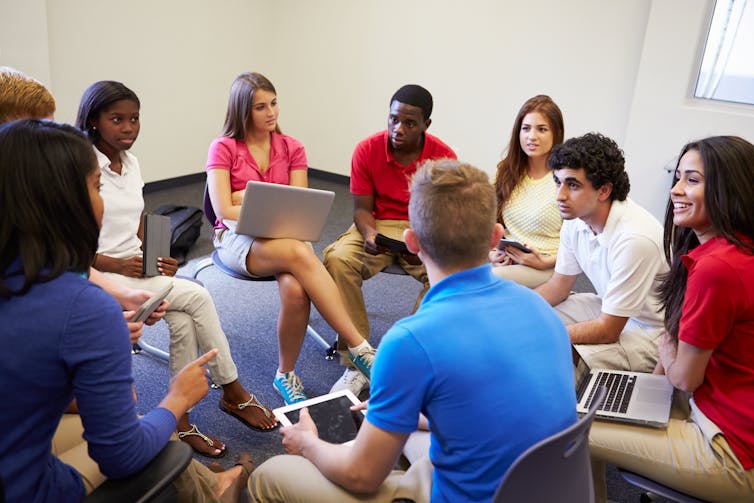
If young people are to engage in democracy and society, young people need to learn how to respectfully disagree. Yet, educators often find it challenging to lead discussions on contentious issues.
Based on my experience as a middle school social studies educator, I’ve discovered that there are ways teachers and others who work with young people can show them how to deal effectively and respectfully with controversial topics – as well as what controversial topics to take up. Though the list of seven ideas I have created below were designed with educators in mind, they are applicable beyond the classroom.
1. Avoid personal attacks
In my former classroom, we had a mantra: “We address the ideas, we don’t attack the person.” When a person feels attacked, they stop listening.
Collectively determine what respect looks and feels like within these types of discussions. For example, a student may raise their voice as they passionately discuss a topic, but that can be perceived as yelling. Have a conversation on students prior to discussion on tone, style and how to engage in a topic when it becomes heated.
The educator’s role as a facilitator is to ensure that students maintain respect for their peers as they passionately express themselves. Making this investment will pay off tremendously for any discussion you have, whether in a classroom or another venue. If young people don’t feel like their viewpoints will be heard and respected, they will likely not speak up.
2. Try easy topics first
Before you dive into a more contentious topic, practice the skills of debate and disagreement with a topic such as school uniforms or cellphone use in classrooms.
A critical element of disagreement must also be empathy. Lived experiences often shape beliefs. Allow young people to share their experiences and their rationale. You may not agree, but you can be sensitive and try to understand their perspective. Remind students to seek to understand without focusing on being right.
3. Introduce familiar as well as new topics
To engage students, select social issues that young people are passionate about. This allows them to utilize their own experiences and knowledge as a frame of reference. It’s important that you truly know and ask your students what they’re interested in. Do not make assumptions. At the same time, recognize that there are topics or issues students may not aware of such as racism, global warming, indigenous and LGBTQ struggles for justice, and that this can be an opportunity to introduce them to narratives outside of their lived experiences or interests.
Be mindful when discussing issues that are connected to young people’s lived experience. Understand that certain topics can evoke strong emotions.
4. Keep discussions structured
Effective discussions are structured, whether it is a formal debate or Socratic seminar where students facilitate their own learning through group discussion rooted in shared texts or sources. No matter the format, establish and communicate clear rules. This will make it easier for you as a facilitator to enforce the rules of engagement and respect.
5. Have students prepare
Students should be prepared for the discussion, which means they should have read, viewed and researched multiple sources on the topic. It’s important to emphasize that students understand the topic from various viewpoints. Allowing time for students to prepare will ensure that all students will be able to contribute and engage in the discussion.
6. Take politics head on
Election season provides an array of topics to analyze, which will provide lots of material to inform student opinions for the discussion. With the midterms, students can discuss and evaluate candidate platforms as they relate to various social issues and their proposals for change. Ballot measures and amendments such as abortion in West Virginia, transgender rights in Massachusetts, and voting rights in Florida are vital to evaluate as well. Have students read and question the ballot. There are many social issues embedded within ballot measures and examining them prepares students to be informed voters when they are a little older. The midterms can serve as a springboard, but you can continue having these discussions throughout the school year.
7. Examine social movements

The complexities of social movements such as women’s suffrage and civil rights are not highlighted enough in middle school and high school curricula. There is usually a focus on leaders and not the long-term collective actions of individuals.
Examining historical and contemporary social movements like pro-choice and pro-life, Black Lives Matter and All Lives Matter, and the LGBTQ movement, provides fertile ground for diverse individual and collective perspectives of an issue.
Students can analyze the websites, news articles of social movements, or engage in a pro/con exercise to grapple with perspectives of a social issue. Questions can be posed to students such as: “Why are people organizing?” or “How does each group see the issue differently?” You could facilitate writing projects to legislators and activists or design a research project where students investigate the purpose, perspective and civic actions of a social movement. A lot of insight can be gleaned from social movements that can enhance discussions. More importantly, young people can find ways to engage in civic action themselves beyond the classroom.
Tiffany Mitchell Patterson, Assistant Professor of Secondary Social Studies, West Virginia University
This article is republished from The Conversation under a Creative Commons license. Read the original article.
No comments:
Post a Comment